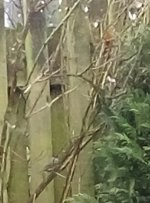jape
Well-known member
he was around for just two or three days, being new to birding and identification i had no idea it was significant.
i was new in this area of UK and the garden was neglected and no-one had been in it much for months. there was a period a week or so after putting out the feeders late in the year when i moved in when suddenly i got visits from goldfinch, greenfinch and bullfinch for just a couple of days then they moved on for some inexplicable reason. i was watching out for chaffinch because as a child they were familar to me. i finally saw one or two in the hawthorns and one day i realised one i had been watching on his own wasn't much like a chaffinch, i identified him carefully as a hawfinch and had no idea they were uncommon.
at about that time he and the other finches moved on and i only rarely see them now apart from greenfinches who spend a lot of time next door in deserted grounds. i am tempted to ask permission to visit that area as no one keeps it up and there are twenty or thirty metres of varied hedging and shrubs where i see lots of bird activity but cannot identify what it is through the xcreening fences and hedge.
i wonder why hawfinches are uncommon, i am sure they were around more when i was a lad 50+ yrs ago? i would like to know more sbout different feed by season, insect hatches, seeds etc and will focus on that as the seasons roll on if i am still about to enjoy it all. some of my friends in different areas of UK have many finches and i think it may be down to planting and surviving weeds.
i was new in this area of UK and the garden was neglected and no-one had been in it much for months. there was a period a week or so after putting out the feeders late in the year when i moved in when suddenly i got visits from goldfinch, greenfinch and bullfinch for just a couple of days then they moved on for some inexplicable reason. i was watching out for chaffinch because as a child they were familar to me. i finally saw one or two in the hawthorns and one day i realised one i had been watching on his own wasn't much like a chaffinch, i identified him carefully as a hawfinch and had no idea they were uncommon.
at about that time he and the other finches moved on and i only rarely see them now apart from greenfinches who spend a lot of time next door in deserted grounds. i am tempted to ask permission to visit that area as no one keeps it up and there are twenty or thirty metres of varied hedging and shrubs where i see lots of bird activity but cannot identify what it is through the xcreening fences and hedge.
i wonder why hawfinches are uncommon, i am sure they were around more when i was a lad 50+ yrs ago? i would like to know more sbout different feed by season, insect hatches, seeds etc and will focus on that as the seasons roll on if i am still about to enjoy it all. some of my friends in different areas of UK have many finches and i think it may be down to planting and surviving weeds.







